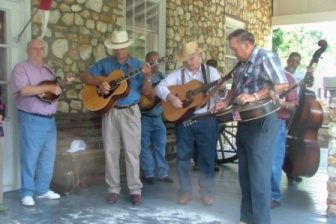Bluegrass music—once referred to as “mountain music in overdrive”—is firmly rooted in the Blue Ridge mountains and foothills of North Carolina. Generations of musicians have grown up steeped in the tradition, and the region is known for its outstanding pickers and singers. While some leave the region to join the national tour circuit, many others pursue their passion here at home in countless festivals, jamborees, and jam sessions.
Bluegrass Pioneers

The music was pioneered in the 1940s by bandleader Bill Monroe and his sidemen who took traditional old-time string band music and jazzed it up with fiery solos, rapid tempos, high harmony signing, and new playing techniques. North Carolina banjo picker Earl Scruggs developed and popularized a syncopated three finger style on the five-string banjo which became the signature sound of the new music. Doc Watson, also from North Carolina, pioneered a flat-picking style on the guitar that inspired generations of guitarists to make the guitar a lead instrument in bluegrass bands.
Bluegrass is a Living Tradition
Bluegrass is a prime example of a living tradition. The music encompasses a broad spectrum of styles from “traditional” (early bluegrass from the 1940s and 1950s) to “progressive” (more recent bluegrass which incorporates elements of rock and jazz). It includes a strong tradition of family bands, in which parents hand the music down to their children and siblings play side by side. Bluegrass musicians continue to expand the tradition by writing new songs and instrumentals.
Standard instrumentation for a bluegrass band includes a five-string resonator banjo, fiddle, mandolin, guitar, and stand up bass. The dobro, a resonator guitar played with a slide, is sometimes included.
Click on the link below to hear a Living Traditions Moment about the origins of the Banjo and the role it played in mountain culture.


